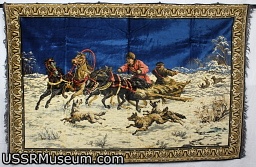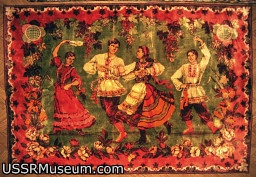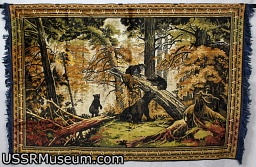The collection includes thousands of things well familiar to most Soviet people, as well as many long-forgotten rarities, whose purpose it is now even difficult to guess. Below only some randomly chosen objects are shown. Many of these things can tell interesting stories about life in the Soviet Union and require explanation. In the museum all objects would be exhibited in a proper context with detailed descriptions.


Various types of film and slide projectors were widely used in schools for education and propaganda. But most important of all - these projectors brought lots of unforgettable magical nights to the Soviet children, who loved to watch beautiful fairy tales using these devices.

In addition to their primary purpose, many radios also were elements of interior decor. Radios of extravagant design like the one below were also indicators of family's welfare and status.

Frequently being the only sources of information about the life abroad, some of these transistor radios have played an important role in the growth of discontent in the country, which ultimately led to the disintegration of the USSR.

Cable radios - loudspeakers directly wired to the all-state radio broadcasting network. This technology had existed only in the USSR. Consisting only of several parts, they were very cheap to produce and reliable in operation, which made them extremely popular. Being powered from the radio network itself, such radios have worked ceaselessly in every Soviet home. During the Second World War, these were the only radios permitted by the government, fearing the enemy's anti-Soviet propaganda on a regular radio network.

Various phones for home and office use, ink wells and pens, sketching tools and lots of other kinds of stationery obsolete by design or completely disappeared from household.

Such lamps in the "Stalin Empire" style were produced in 1930-1950s in a very limited quantity only for the highest party leaders and therefore were symbols of power and status. In the light of these lamps were signed many documents that changed millions of human lives and the course of world history.

All kinds of shavers, razor blades and devices for their sharpening, perfume bottles, tooth powder boxes, unusual hair dryers, combs, mirrors and other vintage objects of hygiene as well as curious medical tools - all these things were once quite ordinary for Soviet people, but now are valuable collectibles.

Various samples of Soviet toys - board games, dolls, toy guns, cars and puzzles would undoubtedly bring nostalgic memories for all former Soviet children, as well as curiosity of today's children and their parents all over the world. Among the toys there are also many kinds of toy soldiers, various military equipment and imaginary spaceships of the future. These toys are well reflecting the spirit of the time and aspirations of the kids in the USSR. The collection includes toys well known to literary every Soviet kid as well as rare ones, which where objects of admiration and envy.

Numerous souvenirs commemorating famous events, such as the victory over fascism, international youth festivals, Gagarin's flight, Moscow Olympics, as well as souvenirs glorifying the labor achievements of the Soviets. Many of these objects - night lamps, pen holders, desk calendars, lighters and statues - were widely used as memorable gifts to co-workers, friends or family members. Engraving greeting inscriptions on the objects themselves was just as customary as signing greeting cards.


Various coal irons and early types of electric irons, folding irons for travel and specialized irons for craftsmanship. Also available are various sewing accessories and samples of dresses typically hand made by women in almost every family, because of inability to buy something more or less suitable in the Soviet shops.

Extensive collection of kitchenware - cookware, all kinds of kitchen tools and accessories, some of which are no longer found in household, utensils with famous symbols of the USSR and lots more. All these were indispensable attributes of Soviet kitchen.

The collection has different kinds of kerosene stoves used in Soviet kitchens as well as the first "unsafe" electric stove, which appeared in the USSR after the Second World War.

The glass holders were mandatory attributes of tea drinking when traveling by railroads, spanning tens of thousands of kilometers across the largest country in the world. Due to their great design (practicality, convenience and aesthetics) they have quickly became one of the most common item of the Soviet household. Because of such immense popularity the glass holders were often used for propaganda. As such, many glass holders were decorated with emblems of significant events, images of famous people, buildings, monuments, and other Soviet symbols. All this was meant to remind Soviet citizen about the greatness of their motherland, fostering patriotism and pride in their country.



Countless pins dedicated to youth organizations, holidays, special events, labor and sport achievements, public organizations, insignia, medals and many many others. Special attention is necessary for a collection of pins with emblems of over 3000 cities of the former Soviet republics. There are also many decorative items: embroideries, rugs, lamps, clocks and other elements of interior decor.






Most of these objects were made for use, however they were quite expensive and considered too beautiful for that. Therefore they were usually acquired just to decorate cupboard shelves in the living room.


In addition to lots of items specific to the Soviet period, there are also many objects of Russian traditional household and various decorative folk art.

Samovar is a traditional water boiler, typically used to make tea. The collection includes samovars of different shapes and sizes, working on coal, electricity or a combination of both. There's also a rarest kerosene samovar, which was produced in a very limited quantity in the very beginning of 20th century.



Today, coal samovars have been almost completely displaced by electric kettles. Samovars are now mostly used as interior decorations and it is customary to paint them with traditional ornaments.

Being a symbol of Russian hospitality, such souvenir samovars were ones of the most popular gifts and souvenirs from Russia among foreign tourists.

Russians love to invite guests for tea and these huge teapots are usually used for big parties.

Dolls like the one below were used to cover the samovars and tea pots to keep them warm. The collection includes different samovar dolls, tea cup sets and other accessories of a Russian tea party, such as spoons, sugar cutters and tongs, tea strainers and other things which are no longer used.


Traditional Russian crafts of Gzhel, Hohloma, Palekh, Kasli and others are now well recognized far beyond Russia.






All shown above is only a very small fraction of the available showpieces. Due to their large quantity and lack of space, great majority of the objects are stored tightly packed and are not available for view yet.


